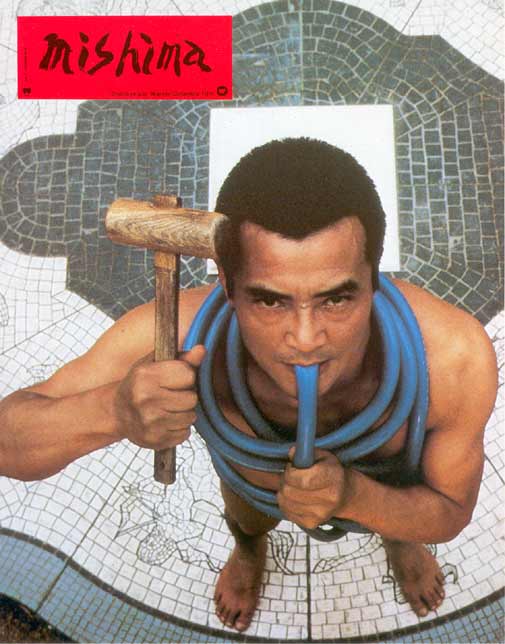
The Wikipedia page for Yukio Mishima links to the category "Writers who committed suicide," underlining our fasciation with artists who kill themselves and the seeming validity it gives their work. This macabre interest is amplified with Mishima, whose ritualistic suicide was not the result of depression or mental illness but a calculated and, in retrospect, inevitable extension of his art. But while Paul Schrader's Mishima: A Life in Four Chapters is structured around Mishima's last day, it avoids the mistake of films like Sylvia and The Hours that depict their subjects' entire lives as a mere foreshadowing of their deaths. Interweaving Mishima's life and work until the two become inseparable, Mishima is a study of one man's obsessive nature that, miraculously, resonates as an exhilarating affirmation of life.
Dividing his film into four chapters, director Paul Schrader (who co-wrote with his brother Leonard) employs a remarkable, ahead-of-its-time structure. Using November 25, 1970 - the day Mishima (Ken Ogata) and five young men from his private army held a Japanese general hostage while the writer addressed the gathered troops before committing seppuku - as its jumping-off point, Mishima cuts between that day, moments from Mishima's past, and scenes from three of his stories. It's an innovative approach, but the most important thing about structure in film isn't innovation but whether the film is organized in a way that allows its characters and ideas room to breathe. In its rigid formal approach, Mishima mirrors the tension between the author's internal and external life, and as the narrative progresses towards the author's ultimate attempt to fuse art and action in death, the film's seemingly separate elements achieve a stunning harmony. By first making us feel the divisions in the author's life - between poetry and physicality, female and male, pen and sword - Schrader's boldly internal approach to Mishima's life illuminates the connections between seemingly disparate elements of the author's sexual ambiguity, radical conservative politics and sadomasochistic impulses. Through Mishima's eyes, we come to see how all of these things spring from the same creative well - Mishima is a tribute to the power of ideas and their various forms.
Schraders also juggles contrasting visual strategies for each section, giving the film an out-of-time feeling that serves its anachronistic subject well. Schrader's worship of Ozu can be felt in the rigid classical compositions of Mishima's stifling childhood; the 1970 scenes have a hand-held immediacy evoke a '60s radicalism that already felt like ancient history in 1985; and the scenes from The Temple of the Golden Pavilion, Kyoko's House and Runaway Horses couldn't be more contemporary. While Ogata is great as Mishima, the star of the film is production designer Eiko Ishioka, whose bold, expressive use of color and space (remastered and gorgeous on the new Criterion release) makes for a thrilling cinematic realization of Mishima's fantasies. The overt theatricality of these scenes frames the biographical sections as another form of performance, Mishima's obsession with perfecting his body and his life's final act as a transformation of his own life into a work of art (and suggests why, for some smart, socially alienated young males, samurai iconography has the same power as trenchcoats and death metal do for some of their angrier peers). For Schrader, whose filmography is filled with protagonists prone to violent acts as a statement and whose own life has been largely devoting to contriving his own persona, this venture into extremely personal territory results in his best work as a director.
But while Mishima is undoubtedly the work of an auteur, it's also a remarkable collaboration between its creative leads. Ishioka's sets, John Bailey's sharp cinematography, the precise editing by Michael Chandler and Philip Glass' exhilarating score (perhaps his best) result in a cinematic experience that is both intellectually provocative and a sensory delight. To say it's the kind of film they don't make any more would ignore the fact that films like Mishima have always been rare; one of exective producers George Lucas and Francis Ford Coppola's acts of atonement for their lavish success, it's the rare American film driven entirely by the strength of its ideas. Mishima is the kind of movie you let wash over you, its stunning images proving that, though rare, it is possible for cinema to serve as a marriage of art and action.

2 comments:
I believe everybody ought to look at this.
Oh my god, there's a lot of helpful info above!
Post a Comment